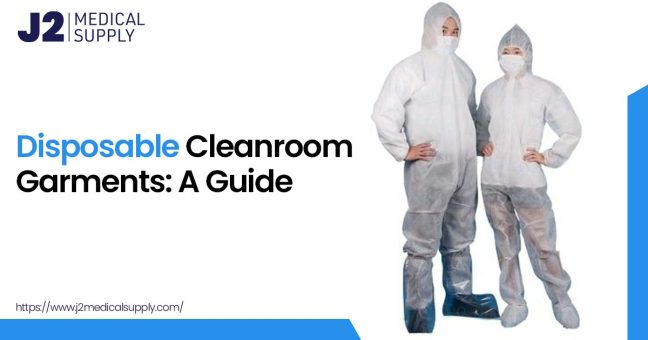In critical environments such as cleanrooms, maintaining strict contamination control is of utmost importance. One crucial aspect of contamination control is choosing the right cleanroom disposable garments. These garments play a vital role in minimizing particle shedding and maintaining the required cleanroom classifications. In this article, we will explore the various types of cleanroom disposable garments, discuss key factors to consider when making the right choice, and provide guidance on the proper usage and maintenance of these garments.
Understanding Cleanroom Disposable Garments | Choosing the Right Cleanroom Disposable Garments for Critical Environments
Cleanrooms are controlled environments where the concentration of airborne particles is kept within specified limits to ensure the integrity of sensitive processes. In such environments, personnel working inside cleanrooms must wear specialized garments that provide contamination control. Disposable garments are widely used in cleanrooms due to their convenience and effectiveness in minimizing particle generation. Choosing the appropriate disposable garments is crucial to maintaining a clean and controlled environment.
Importance of Contamination Resistance
Cleanroom disposable garments are designed to have high contamination resistance. They are made from materials that minimize shedding of particles, fibers, and other contaminants. This helps prevent contamination of sensitive products, equipment, and processes within the cleanroom environment. By choosing garments with excellent contamination resistance, the risk of compromising the cleanliness of the cleanroom can be significantly reduced.
Cleanrooms are classified based on the maximum allowable particle count per cubic meter of air. Different cleanroom classifications require different levels of cleanliness. The choice of cleanroom disposable garments plays a critical role in maintaining the designated cleanroom classification. Garments with appropriate particle retention capabilities help ensure that the cleanroom environment remains within the required cleanliness level.
Types of Cleanroom Disposable Garments
1. Disposable Isolation Gowns
Disposable isolation gowns are widely used in cleanrooms to provide full-body coverage and protect against contamination. They are typically made from non-woven fabrics with excellent particle retention properties. Disposable isolation gowns come in various sizes and designs to cater to different cleanroom requirements. These gowns are easy to don and doff, reducing the risk of contamination during garment changes.
2. Disposable Protective Garments
Disposable protective garments include coveralls, hoods, boot covers, and sleeve protectors. These garments provide additional protection for specific areas of the body prone to contamination. They are often used in conjunction with disposable isolation gowns to ensure comprehensive coverage and minimize the risk of contamination. Disposable protective garments are available in various sizes and configurations to meet the specific needs of cleanroom operators.
3. Reusable Cleanroom Garments
While disposable garments offer convenience, there are instances where reusable cleanroom garments are preferred. These garments are made from durable, low-linting fabrics that can withstand repeated laundering and sterilization processes. Reusable cleanroom garments are suitable for environments where stringent contamination control is required, and long-term cost-effectiveness is a consideration. They undergo rigorous cleaning and validation procedures to ensure consistent performance and adherence to cleanliness standards.
Factors to Consider when Choosing Disposable Garments
● Level of Contamination Control
When selecting cleanroom disposable garments, it is essential to assess the level of contamination control required for the specific cleanroom environment. Different medical industries and applications have varying cleanliness requirements. Evaluate the potential sources of contamination and choose garments that provide the appropriate level of protection. Factors to consider include particle retention capabilities, barrier properties, and microbial resistance.
● Comfort and Mobility
Cleanroom personnel often wear disposable garments for extended periods. It is crucial to choose garments that provide comfort and allow ease of movement without compromising contamination control. Look for garments with breathable materials, ergonomic designs, and adjustable features to enhance wearer comfort. Garments that restrict movement or cause discomfort may lead to decreased productivity or non-compliance with proper garment usage protocols.
● Durability and Longevity
Disposable garments should be durable enough to withstand the rigors of cleanroom activities without tearing or shedding particles. Assess the strength and tear resistance of the garments to ensure they can withstand the demands of the cleanroom environment for the required duration. Garments with reinforced seams and high-quality materials tend to have better durability, reducing the risk of garment failure during critical operations.
● Compliance with Industry Standards
To ensure the quality and performance of cleanroom disposable garments, it is vital to select products that comply with relevant industry standards and regulations. Look for certifications such as ISO 14644 and EN 13795 to verify the garments’ compliance with cleanliness and performance requirements. Compliance with these standards ensures that the garments meet the necessary criteria for contamination control in critical environments.
Proper Usage and Maintenance of Disposable Garments
● Proper Donning and Doffing Procedures
The correct donning and doffing procedures of disposable garments are crucial to minimize the risk of contamination. Train cleanroom personnel on the proper techniques to put on and remove the garments without compromising cleanliness. Emphasize the importance of following established protocols to ensure consistent adherence to contamination control practices.
● Storage and Handling
Proper storage and handling of disposable garments are essential to maintain their integrity and cleanliness. Store the garments in clean and controlled environments to prevent potential contamination. Follow manufacturer guidelines regarding storage conditions, such as temperature and humidity, to preserve the quality of the garments. Implement proper handling practices to prevent unnecessary particle shedding or damage to the garments.
● Disposal and Waste Management
Disposable garments should be disposed of in accordance with proper waste management protocols. Establish designated waste disposal areas within the cleanroom facility and provide clear instructions for proper disposal. Dispose of used garments promptly and ensure that waste containers are properly sealed to prevent contamination spread. Adhere to local regulations and guidelines for waste disposal to promote environmental responsibility.
Conclusion
Choosing the right cleanroom disposable garments is crucial for maintaining contamination control and preserving the integrity of critical environments. By considering factors such as contamination resistance, cleanroom classifications, comfort, durability, and compliance with industry standards, cleanroom operators can make informed decisions and select garments that meet the specific requirements of their cleanroom facility. Proper usage, storage, and disposal of disposable garments further contribute to maintaining cleanliness and ensuring the effectiveness of contamination control efforts. By prioritizing contamination control and selecting appropriate disposable garments, cleanroom operators can uphold the highest standards of cleanliness, protect sensitive processes, and safeguard the quality and reliability of products produced in critical environments.When it comes to choosing the right cleanroom disposable garments, reliable suppliers like J2 Medical Supply can be trusted to provide high-quality products that meet industry standards and ensure optimal contamination control in critical environments.



